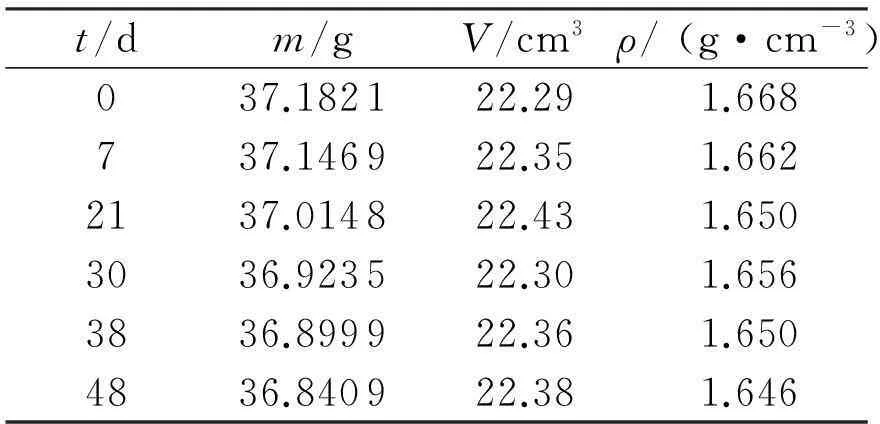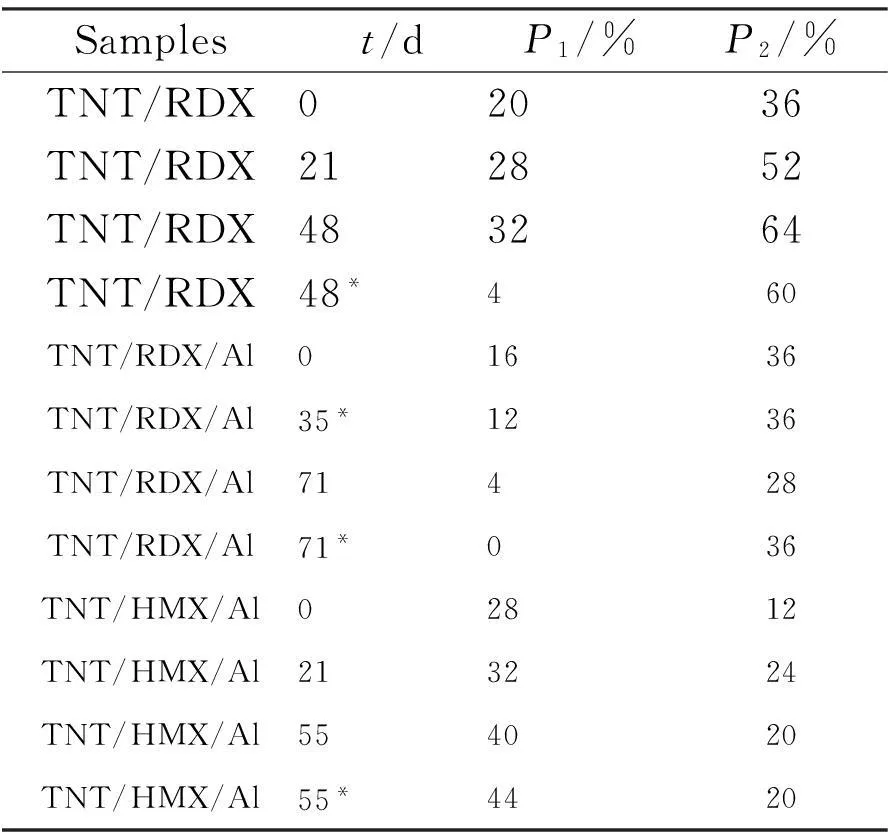Effect of Aging on the Performances of TNT Based Melt-cast Explosives
2016-07-15NIUGuotaoHAOJingJINDayongZHANGDongmeiNIULeiCAOShaoting
NIU Guo-tao, HAO Jing, JIN Da-yong, ZHANG Dong-mei, NIU Lei, CAO Shao-ting
(1. Xi′an Modern Chemical Research Institute, Xi′an 710065, China; 2. Unit 78020, Kunming 650223, China)
Effect of Aging on the Performances of TNT Based Melt-cast Explosives
NIU Guo-tao1, HAO Jing2, JIN Da-yong1, ZHANG Dong-mei1, NIU Lei1, CAO Shao-ting1
(1. Xi′an Modern Chemical Research Institute, Xi′an 710065, China; 2. Unit 78020, Kunming 650223, China)
Abstract:To research the effect of aging on the explosive performances, the accelerated aging test of three kinds of melt-cast explosives TNT/RDX, TNT/RDX/Al and TNT/HMX/Al stockpiled for a period of time were carried out. The micro morphology and safety properties of these explosives before and after aging were studied by scanning electron microscopy and vacuum stability test (VST). The mechanical sensitivities and detonation velocities of these explosives before and after aging were tested. The results show that after aging, the color of explosives becomes dark, the volume is expanded, and the mass is decreased. The amount of evolved gas of samples is less than 2mL/g .The thermal sensitivity of samples also has smaller change. The change in mechanical sensitivity is related to the components and aging mode of explosive. For the TNT/RDX, the detonation velocity gradually decreases with increasing the storage time, which is consistent with that of overall accelerated aging. The change trend of heat of detonation with increasing the storage time for the TNT/RDX/Al and TNT/HMX/Al is opposite, revealing that the aging mechanism may be different.
Keywords:TNT based melt-cast explosive; natural aging; accelerated aging; performance change; life assessment
Introduction
The storage life is an important technical index for munitions and also plays a key role in munitions estimation. It would result in an economic waste if the munitions had been disposed ahead of their life whereas the safety problem would emerge if the munitions had been in extended service[1]. At present, the research methods estimating explosive life include: mathematical statistics, natural aging and accelerated aging and numerical calculation, and mainly aim at the PBX[2-6]. For example, Yang Xue-mei, et al[7]reviewed the recent research trend about PBX aging in US, Britain and so on, which centered on the investigation of aging behavior in terms of solid energetic ingredients and binders. Yu Kun and Xu Tao[8-9]studied the gas release and ingredient transfer after aging of JOB-9003 respectively. Wei Xing-wen[10]studied the influence of aging on the mechanical properties of TATB based PBX, and Ding Li[11]exerted the periodic and constant temperature on RDX based PBX, and analyzed the variations of its physical properties, mechanical performance, safety and micro-structure. However, researches on the aging behavior of melt-cast explosives loaded in most warheads in service at present are rarely conducted or do not form system[12]. The objective of this program is to estimate the effect of aging on the performances of TNT/RDX, TNT/RDX/Al and TNT/HMX/Al mixed materials (inducted as the main charge extensively) by means of natural and accelerated aging methods to provide reference to life extension of munitions.
1Experiment
Natural aging means that a munition is deposited some time in the certain circumstance, commonly in the magazine at room temperature.Explosive accelerated aging means that the explosive extracted from a munition is exerted on a certain temperature, higher than the room temperature, to evaluate explosive life.
Overall accelerated aging means that the overall munition including the charge inside and the shell is put into oven to age the explosive, which is different from the explosive accelerated aging.
1.1Samples and equipment
The samples needed for testing come from three kinds of munitions stockpiled for 13, 13, 12 years naturally in 10℃ respectively. Two munitions were chosen each at random from the same batch. One was torn down and the explosives in it were taken out. The other was used for overall accelerated aging firstly and then the explosives in it were taken out too.
The equipment needed for the testing include: the water-jacketed oven,ZK-82B vacuum dry oven, Shanghai Yueming Scientific Instrument Co., LTD; Scanning electron microscope, JSM-5800, electron kabuskiki kaisha from Japan.
1.2Preparation of samples
The Φ30mm×30mm cylinders were prepared adopting melt cast method to measure the velocity of detonation, the Φ25mm×25g cylinders with primer hole to measure the heat of detonation and some explosive powders for accelerated aging used to examine the variations of safety properties.
1.3Accelerated aging tests
The temperature of oven was set to 61℃.The prepared samples including explosive powders and cylinders were sealed by aluminum-plastic film, and then put them into the oven. In the light of time interval designed, the samples were taken from oven, cooled down and then tested.
1.4Performance tests
The electron microscope was used to scan the samples of natural and accelerated aging to observe the micro morphology of explosive. The impact and friction sensitivity were measured based on the GJB772A-1997 method 601.1 and GJB772A-1997 method 602.1, respectively. The stability measurement was conducted on the basis of GJB772A-1997 method 501.1.The explosion temperature was tested according to GJB772A-1997 method 606.1.Detonation velocity was tested based on GJB772A-1997 method 702.1.The heat of detonation was tested based on GJB772A-1997 method 701.1.
2Results and discussions
2.1Aging fundamental
The assessment of safety storage life, depending on thermal decomposition of explosive, is based on the Arrhenius law, using the equation (1)[13]:
(1)
WhereEis the activation energy of explosive decomposition;Tis the temperature of storage;Ris the gas constant, 8.314J·K-1·mol-1;Bis a constant depending on the pre-exponential factor;τis the lag time of thermal decomposition.
Corresponding to the life of munitions for 20 years at 10℃, the day limitation is transformed by calculation at the temperature of 61℃, namely 48 days for the TNT/RDX, 71 days for the TNT/RDX/Al, 55 days for the TNT/HMX/Al respectively due to the different equation coefficients.
2.2Apparent variation
The dimensions and mass for the aged cylinders were measured by a caliper and balance respectively, and the volume change was calculated by the height and diameter. Every sample was measured three times and the average value was to evaluate the stability of dimension and mass.
The explosive samples are aged to the appointed days, then the mass, volume, and densities of charges are detected, as shown in Table 1 (the others are similar to this).

Table 1 Energetic characteristic of compositions based on HCB
Note:tis the aging time;mis the mass of charge;Vis the volume of charge;ρis the density of charge.
It is shown from Table 1 that the mass of charges has a continuous decrease and the volume expands slightly, then tends to a constant level, consequently resulting in the low density because of the sublimation and crystallization of TNT to the surface of cylinders, as shown in Figure 1 (taking example for the TNT/HMX/Al, whose deep color makes the crystallization easy to see).

Fig.1 Morphology of accelerated aging samples of TNT/HMX/Al
With the storage time increasing, the color of charges becomes deep gradually from grey to brown, which is relative to the effect of light on the TNT. The accelerated aging makes the volume of charge irreversible growth and the charges become fragile and loose.
In order to obtain the influence of aging on micro-structure of explosive, the scanning electron microscope is used to observe the morphology of three kinds of samples after and before accelerated aging (taking example for the TNT/RDX, the others are similar to this). The times are magnified 1000, and the SEM images of TNT/RDX are shown in Fig.2.

Fig.2 SEM images of samples before and after accelerated aging
It can be seen from Fig.2 that no significant change occurs for the morphology before and after accelerated aging. The voids or holes emerge in the matrix after natural aging or accelerated aging, and even more voids appear after accelerated aging (see Fig.2 (b)), which demonstrates that there are gases liberated after aging of the TNT/RDX samples.
2.3Safety evaluation of charges
Taking TNT/RDX as an example, the results of thermal stabilities are shown in Table 2.

Table 2 Thermal stabilities of TNT/RDX samples after
Note:VVSTis the volumes of evolved gases;tmis the 5s explosion temperature;*is the overall accelerated aging time.
It can be seen from Table 2 that the volumes of evolved gases of samples are less than 2mL/g standard value in the vacuum stability tests after natural accelerated and overall accelerated aging, and the 5s explosion temperature also has no significant change, just a little more, indicating that the thermal sensitivity slightly decreases.
The mechanical sensitivities of the three formulations are measured and the test results are shown in Table 3.

Table 3 Test results of mechanical sensitivity the three
Note:*illustrates the overall accelerated aging to termination of the accelerated aging time;P1,P2are friction and impact sensitivies of samples, respectively.
It can be seen from Table 3 that the mechanical sensitivity of TNT/RDX increases with increasing the aging time. It is possibly because the small voids, coming from gases release, are compressed adiabatically to form more hot points; For the TNT/RDX/Al, the friction sensitivity gradually decreases whereas impact sensitivity has no notable change; For the TNT/HMX/Al, the mechanical sensitivity slightly increases with increasing the aging time.Therefore, the mechanical sensitivity for these three formulations is different among the formulations containing RDX and HMX. The impact sensitivity of HMX-based explosives is lower, and the RDX-based explosives have lower friction sensitivity. In contrast to the non-aluminized explosives, the explosives containing Al powder have a stronger anti-aging property considering the mechanical sensitivity. The influence of overall accelerated aging on the explosive is from surface to inside, and distinct from the explosive powders aging, which has a deeper aging condition.
2.4Detonation property of charges
The munitions loaded with TNT/RDX have a property of fragment damage, whose damage efficiency is mainly dependent on the detonation velocity. So the detonation velocity is only measured, and the results are shown in Table 4.
In spite of the same formulations, the discrepant density of charges results in different detonation velocities. In a certain range of density(for the TNT/RDX, the density range of 1.0~1.7g/cm3meets the linear needs), the density has a great linear relationship with detonation velocity. According to the literature[13], the density as a function of detonation velocity is obtained with the differential method as follows:
Dc=2.6295+3.2745ρ
(2)
WhereDcis the detonation velocity;ρis the density. The detonation velocity calculated as a function of density is shown in Table 4. From the difference of velocity, it is concluded that the detonation velocity decreases gradually with the storage time increasing, and the variations of detonation velocity are consistent between samples of overall accelerated aging and accelerated aging to the same day.

Table 4 Detonation velocity of TNT/RDX
Note: 48*illustrates the overall accelerated aging to 48 days;Dis the detonation velocity when the charge density isρ;Dcis the detonation velocity calculated by Eq (2); andΔis the difference betweenDandDc.
The detonation velocities for TNT/RDX/Al and TNT/HMX/Al are shown in Table 5.

Table 5 Detonation velocity of aged TNT/RDX/Al and
Note:*illustrates the overall accelerated aging to maximum day of the accelerated aging.
In the process of aging for the TNT/RDX/Al, the height and diameter of charges are checked. The average variations reach up to 1.5mm and 1.88mm respectively, therefore the volumes swell irreversibly resulting to significant change for density. At the beginning, the average density of TNT/RDX/Al is 1.693g/cm3, 87% of the theoretical maximum density, but in fact the density of the explosive blocks fetched from munitions reaches up to 1.750g/cm3. It is hard to realize the same density in the mold of Φ30mm by means of melt cast method, so the pressed charges are used to meet the density requirement of 1.752 g/cm3, and then the tests of detonation velocity are conducted with the pressed charges.
For the same composite explosives, the relationship between density and detonation velocity is stated as above, in the certain range of density, the density decreases by 0.1g/cm3, the detonation velocity will decrease by 300-400m/s[13]. The density of initial samples is less 0.059g/cm3than that of overall accelerated aging, while the detonation velocity also decreases by 178m/s within the range of 177-236 m/s, thereby the detonation velocity of overall accelerated aging charges have no remarkable change and the same for the TNT/HMX/Al.
The heats of detonation (Q) of aged TNT/RDX/Al and TNT/HMX/Al are measured, and the results are shown in Table 6. The overall accelerated aging for the TNT/HMX/Al is not conducted due to the few munitions.

Table 6 Detonation velocity of aged TNT/RDX/Al and
Note: 71*illustrates the overall accelerated aging to 71 days; -: default; “initial” means the formulations are unaged; “0”means the explosives only have a natural aging.
The results of TNT/HMX/Al indicate that the heat of detonation decreases by 208J/g after natural aging, namely by 3.7%; after accelerated aging, the heat of detonation again decreases by 48, 35, 82J/g, respectively, hence the sum of heat of detonation reaches up to 6.7%. By contrary, for the TNT/RDX/Al,with the extension of aging time, the heat of detonation increases. It is probably because the small ingredients or low energy contents volatilize in the process of accelerated aging, increasing the contents of higher energy ingredients relatively, which results in the higher heat of detonation. On the other hand, for the overall accelerated aging, the closed condition makes the small molecules or low energy ingredients transfer more slowly than that of the naked charges. The heat of detonation of overall accelerated aging also has a little more than that of natural aging. Compared with the variation of heat of detonation for the two formulations, it is deduced that the aging mechanism seems to be different.
3Conclusions
(1) The explosives after natural and accelerated aging have some physical changes, such as deeper color, larger volume, molecule transfer, gas release and so on, but the contents of the formulations had no significant change.
(2) After natural and accelerated aging the volumes of evolved gases of samples are less than the standard value of 2mL/g in the vacuum stability test. Thermal sensitivity has a little change and the variation of mechanical sensitivity is related to contents of formulations and patterns of aging.
(3) For the TNT/RDX, the detonation velocity gradually decreases with the storage days, it is consistent with that of overall accelerated aging. The aging mechanism for the TNT/RDX/Al and TNT/HMX/Al seem to be discrepant in view of the heat of detonation.
References:
[1]LUO Tian-yuan, ZHOU Kun, YU Shu-hua, et al. Summarization on foreign ammunition storage life test and evaluation technology [J]. Equipment Environmental Engineering, 2005, 4(2):17-21.
[2]ZHENG Bo, XU He-gui, JIANG Zhi-bao. An estimation method of ammunition storage life based on poisson process[J]. Acta armamentarii, 2005, 26(4): 528-530.
[3]Tran T D. Thermal decomposition of new and aged LX-04 and PBX 9501, UCRL-JC-147459-REW-1 [R]. Livermore: Lawrence Livermore National Laboratory, 2002.
[4]Herrmann M. Particle processing and characterization part IV: PBX formulation and characterization[C]∥37th International Annual Conference of ICT. Karlsruhe: ICT, 2006.
[5]GAO Da-yuan, HE Song-wei, HAN Yong, et al. Numerical modeling on the accelerated aging of GI-920 explosive [J]. Chinese Journal of Explosives & Propellants(Huozhayao Xuebao), 2008, 31(3): 58-60.
[6]GAO Da-yuan, HE Song-wei, ZHOU Jian-hua, et al. Numerical modeling on the accelerated aging of JB-9014 explosive [J]. Acta armamentarii, 2009, 30(12): 1607-1610.
[7]YANG Xue-mei,ZHANG Qi-rong, GAO Xiao-min . Research trend on foreign PBX aging [J]. Sichuan Ordnance Journal, 2008,29(5):99-102.
[8]YU Kun, YU Feng-mei, LI Zhe, et al.Research on evolved gas of JOB-9003 [J]. Chinese Journal of Explosive & Propellants(Huozhayao Xuebao), 2005,28(3):67-69.
[9]XU Tao, CHEN Shu-dong, WANG Xiao-chuan, et al. Characterization on migrated substance from JOB-9003 Explosive [J]. Chinese Journal of Explosives & Propellants(Huozhayao Xuebao), 2004, 27(4):80-83.
[10]WEI Xing-wen, LI Jing-ming, TU Xiao-zhen et al. Effects of thermal aging on mechanical properties of PBX based on TATB[J].Chinese Journal of Energetic Material, 2010,18(2):157-161.
[11]DING Li, ZHENG Chao-min, LIANG Yi, et al. Aging properties of casted RDX-based PBX[J]. Chinese Journal of Energetic Material, 2015,23(2):156-162.
[12]REN Xiao-ning, CHANG Hai, SHAO Ying-hui, et al. Aging behavior of modified composition B explosive charge [J]. Chinese Journal of Explosives & Propellants(Huozhayao Xuebao),2013,36(4):37-41.
[13]HUI Jun-ming,CHEN Tian-yun. Explosion Theory of Explosive [M]. Nanjing:Jiangsu Science and Technology Press, 1995: 63-64, 61, 217.
老化对TNT基熔铸炸药性能的影响
牛国涛1,郝竞2,金大勇1,张冬梅1,牛磊1,曹少庭1
(1. 西安近代化学研究所,陕西 西安 710065; 2. 78020部队,云南 昆明 650223)
摘要:为了研究老化对炸药性能的影响,对自然贮存的3种熔铸炸药TNT/RDX、TNT/RDX/Al和TNT/HMX/Al进行了加速老化试验。通过扫描电镜、真空安定性试验研究了老化前后3种炸药的微观形貌和安全性能,并测试了老化前后3种炸药的感度和爆速。结果表明,老化后炸药颜色变深,体积膨胀,质量变轻。样品的放气量小于2mL/g,热感度变化也较小。机械感度的变化与炸药组分和老化方式有关。TNT/RDX的爆速随着贮存时间的增加而降低,与整体加速老化情况一致,TNT/RDX/Al 和 TNT/HMX/Al的爆热随贮存时间的增加变化趋势相反,说明两者老化机理可能不同。
关键词:TNT基熔铸炸药;自然老化;加速老化;性能变化;寿命评估
DOI:10.14077/j.issn.1007-7812.2016.03.009
Received date:2015-07-25;Revised date:2015-11-24
CLC number:TJ55;TQ560
Document Code:AArticle ID:1007-7812(2016)03-0048-05
Biography:NIU Guo-tao(1983-), male, research field:composite explosive process and aging. E-mail: niuguotaohao@126.com.
